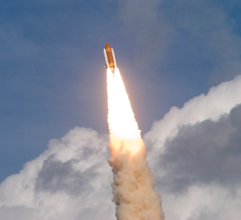Global Scans · Space · Weekly Summary

- [New] By integrating attack tactics used in incidents such as the SolarWinds' cyber supply chain attack and the ViaSat satellite modem compromise in Ukraine, the game simulates a full attack lifecycle - from a stealthy initial breach to eventual disruption of satellite services. Home
- [New] As the world's reliance on satellites intensifies, so too does the risk of sophisticated cyberattacks targeting space-based systems and critical infrastructure, with almost 240 cyber hacks targeting the space sector in the past two years. Home
- [New] Crusoe will deploy its Cloud platform on Starcloud-2 satellite scheduled for launch in late 2026, with limited GPU capacity expected to be available from orbit by early 2027. NextBigFuture.com
- [New] AST SpaceMobile is accelerating its production and operations, and by the end of 2026, the space telecommunications firm plans on having between 45 and 60 BlueBird satellites in LEO servicing the United States, Europe, and Japan. investing.com
- [New] BlueBird 6 is 3.5 times the size of its predecessors and will support 10 times their data capacity after it launches from India's Satish Dhawan Space Center next week. investing.com
- [New] Bluebird 6 will feature the largest commercial phased-array antenna of any satellite in low Earth orbit at 2,400 square feet. investing.com
- [New] An advanced new satellite-based digital communications backbone for future warfare will be critical to keeping the U.S. military on the bleeding edge of technology in the 21st century. The Washington Times
- [New] Google, SpaceX, and Blue Origin Plan To Put AI in Space. Reason.com
- [New] In early November Google announced Project Suncatcher, which aims to launch solar-powered satellite constellations carrying its specialty AI chips, with a demonstration mission planned for 2027. Scientific American
- [New] Prime Minister Narendra Modi has intensified efforts to bring India shoulder to shoulder with China, which already operates its own space station and aims to send astronauts to the moon by 2030. Outlook Business
- [New] The European Space Agency's Zero Debris Charter aims to eliminate the creation of new orbital debris by 2030 through voluntary design and disposal standards. Belfer Center
- [New] Space combat moves from science fiction to threat as China, Russia outpace U.S. The Washington Times
- [New] Google will soon begin construction of AI data centers in space. Last Week in ConTech
- [New] British Airways has partnered with Starlink to bring fast, reliable satellite Wi-Fi to over 500 aircraft from 2026. Meon Travel
- President Trump's national industrial strategy centers on expanding U.S. dominance in semiconductors, AI, rare earth production, clean technology, space, and other emerging technologies expected to dominate the global economy in the 2030s. Technocracy News
- The expansion of space-based networks through Starlink, Amazon Kuiper and future satellite services will establish coverage that extends past traditional ground-based boundaries. aipix.ai
- As SpaceX continues to push the boundaries of what is possible, its role as a cornerstone of the commercial space economy will only solidify. Ainvest
- In the U.S., SpaceX has filed patents exploring how low-resistance vacuum environments might reduce satellite launch costs by up to 60%. International Defense Security & Technology
- The U.S.-China space race carries risks, including unmanaged competition and potential escalation. Ainvest
- The U.S.-China space race intensifies as a $1 trillion economic and military battleground by 2032, driven by AI, satellite networks, and autonomous systems. Ainvest
- By the late 2050s, we may see the development of space-based solar power and lunar energy resources, creating entirely new energy paradigms and supporting space industrialization. Futurist Speaker on AI Leadership, Future of Work, Futu
Last updated: 15 December 2025
